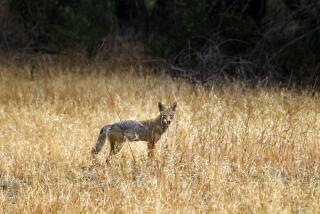Woodland Hills : Pet in Fenced Yard Falls Prey to Coyotes
- Share via
She was a 12-year-old English spaniel named Emily.
She was a gift, a bit of furry cheer to boost her mother’s spirits after the family’s previous pet was put to sleep, said Karen Jiler of West Hills.
But Emily met a far less humane fate Friday morning when she was ravaged by the coyotes that roam the Santa Monica Mountains above her owners’ Woodland Hills home.
“She was nothing but a carcass and a head,” Jiler said.
Emily’s owner, Bobbie Parry, said she and her husband had brought the dog back to the house only a month ago after extensive earthquake repairs forced them to board Emily at a Van Nuys kennel.
The dog normally slept in the garage, but during the recent heat wave it had access to a fenced-in side yard at night, Parry explained.
“It was very hot so we didn’t want to close the door,” she said.
Although homeowners have maintained a sometimes tense coexistence with coyotes since the city stopped trapping them two years ago, Parry said she had never imagined that her beloved pet would fall prey.
“We’re heartsick,” she said.
Jerry Greenwalt, assistant general manager of the Los Angeles Department of Animal Regulation, said that though pet owners should take care to protect their animals from the heat, they should be aware that pets may need protection from predators as well.
“I don’t think there’s anything special you can do to keep the coyotes away,” he said.
“We’re telling people to keep their pets in,” said Lisa Paulson of the Veterinary Medical Center in Woodland Hills. She explained that as coyotes’ natural habitat shrinks due to development, they are forced to look elsewhere for food.
“They’re not afraid . . . of people as much because there’s not as many places for them to go,” she said.
(BEGIN TEXT OF INFOBOX / INFOGRAPHIC)
Urban Predator Conflicts with coyotes, usually attacks on small pets, are fairly common in hillside and canyon areas, but there are ways pet owners can protect their animals. Animal regulationofficials and veterinarians stress that despite the recent heat wave, residents in areas where coyotes are known to exist must continue to take precautions with their pets. “Bring’em in at night,” said one. *
Coyote (Canis latrans) Size: 32 to 40 inches long with 12- to 15- inch bushy tail; about 24 inches high at shoulder; weighs 30 to 50 pounds. *
Notable markings: Gray on back, reddish- tan on flanks, yellowish- brown legs, feet and ears. *
Food: Opportunistic, eating whatever is available, including rodents, fruit, insects, pet food and garbage. *
Habits: Mostly nocturnal, spends its days in chaparral and wanders into residential areas after dark. Can run up to 35 m.p.h. and cover 10 to 15 miles a night. Normally, dens are in ground but coyotes often use other shelter no more than six miles from water. Some live full time in urban areas such as vacant lots. Have been known to mate with domestic dogs. *
Voice: Distinctive howl, mixed with yaps at dusk or near dawn. *
Safety Tips Never feed coyotes. Cover trash bins. Never leave pets or their food outdoors. Remove ripened fruit from trees and grounds. Fence yards or brushy slopes. Coyotes can dig under fences and scale fences more than six feet high. Bury bottom of fence at least six to 12 inches. A fence at least eight feet high and tilted 45 degrees outward, away from yard, can deter coyotes.
Who to Call Currently, no government agency will trap coyotes in the city, but the Department of Animal Regulation provides a brochure on coexisting with coyotes; call (213) 893- 8400 or the West Valley shelter at (818) 882- 8800 or East Valley shelter at (818) 764- 7061. Sources: Encyclopedia americana, Peterson Field Guide to Mammals.
More to Read
Sign up for Essential California
The most important California stories and recommendations in your inbox every morning.
You may occasionally receive promotional content from the Los Angeles Times.













